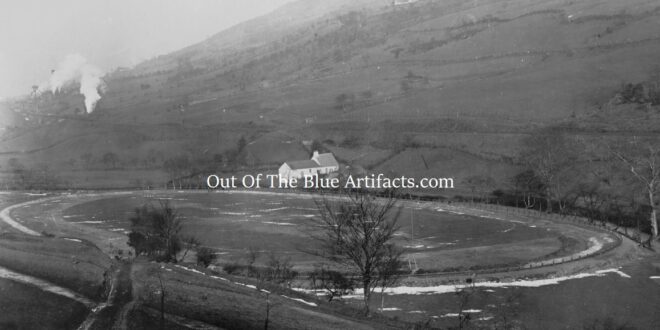Abertillery Cycle Track.
Cycling in the Abertillery district really took off in the late 1880’s when individuals and groups took to the roads on their bicycles. Retailers in the large towns advertised bicycles for sale and new technology applied at this time made cycling easier and more comfortable.
In the late 1880’s bicycle riders were very often caught for not using a lamp on their bicycles after dark, many landed up in court and were fined between 5s. shillings and 20s. shillings. In the early 1900’s cyclists were also caught and brought in front of magistrates for the offence of “Furious Driving” going faster than they should on any roadway and the fine for that offence was between 10s. shillings to £2 or even 3 days imprisonment.
 The Formation of the Cycling Club.
The Formation of the Cycling Club.
On Tuesday 17th of June 1890, the Abertillery Cycle Club was formed (as seen in the clipping left). The club started off with 20 gentlemen including Mr E. Price; Mr G. Ihringer; Mr H. Burrows; Mr J. Jones; Mr H. Ashley; Mr E. Michael and Mr J. Meredith: Their headquarters was at the Wilkins Coffee Tavern, Somerset Street, Abertillery.
The early cycling groups seemed to have had a bugler in their party, it must have been a legal requirement similar to automobiles to alert people and pedestrians that the cyclists were approaching. It must have been an important role within the group as the bugler was very often named in reports and there was a secondary so called (sub-bugler) in many clubs.
The Cycle Track Proposal.
The need for a cycling track was first raised in May 1890 when the Abertillery Local Board was asked to include a cycle track at their proposed recreation ground. The area had seen a steady growth of a lot of cyclists over the past few months with a great interest in the pastime but with a lack of proper road surfaces they really needed a place to ride.
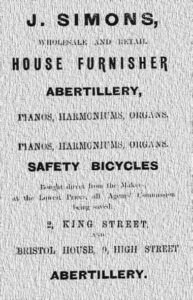 Messrs J. Simons.
Messrs J. Simons.
At the beginning of 1891 Messrs J. Simons of Bristol House, High Street, Abertillery (where Iceland Food Store is today) started selling “Safety Bicycles” (as seen in the advertisement right).
A Bicycle Race.
On Monday 7th of September 1891, a ten-mile bicycle race took place at Merthyr between Mr George Meredith and Mr Lewis Adams, both of Abertillery. Mr George Meredith won the competition by a quarter of a mile.
The new pastime of cycling was gaining a lot of interest and the newspapers were reporting on various local rides made by individual and group cyclists. One of these reports were made in late September 1891 when two of the members of the Abertillery Town Cycling Club left their homes and visited Brecon, Merthyr and returned home via Dowlais. The distance covered during the day was 63 miles, it was stated “not a bad day’s ride when the hilly terrain and badly made roads were taken into account”.
In July 1894 the Abertillery Cycling Club held a meeting in Wilkins Coffee Tavern and the following officers were elected – Mr G. Ihringer (Captain); Mr F. Lintern (Vice Captain); Mr J. Wright (Secretary); Mr O. Hancock (Treasurer) and the Bugler was Mr W. Rex:
In March 1895 the Abertillery Cycling Club held the annual meeting at the Wilkins Coffee Tavern. The following officers were elected – Mr G. Ihringer (Captain); Messrs Rex and G. Meredith (Vice Captains); Mr J. Pollard (Secretary) and Mr O. Hancock (Treasurer):
On Wednesday 13th of February 1895, the Abertillery Cycling Club held their annual supper and smoking concert at Messrs Wilkins Coffee Tavern. Mr James was chairman and the evening was spent singing and dancing with the entertainment provided by Mr D. Jones, Mr Rex, Mr Gallion, the host Mr Wilkins.
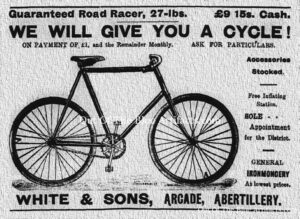 Messrs White & Sons.
Messrs White & Sons.
In 1898 Messrs White & Sons of the Arcade, Abertillery (as seen in the advert left) were selling bicycles at a cost of £9. 15s. 0d. This is the equivalent to about £1,120,60p in today’s money.
Messrs White & Sons were one of the first shops to be established in the arcade, Abertillery.
Abertillery Wheelers.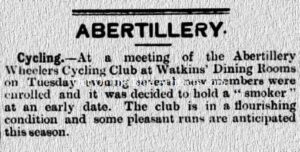
In April 1900 the Abertillery Cycling Club was being reported as being called the Abertillery Wheelers Cycling Club, their headquarters was still in the Wilkins Coffee Tavern, Somerset Street, Abertillery. It seems the club may have adopted the name “Wheelers” during this time as it hadn’t been mentioned in reports before this date?
The Nantyglo and Blaina Cycling Club.
In May 1900 it was reported that a cycling club had been officially formed for the Blaina and Nantyglo area. It was stated that fifty members had joined. The following officers of the Nantyglo and Blaina Club were elected – Mr J. S. Parsons (Captain); Mr D. Harris (Secretary); Mr T. Huggins (Deputy Secretary) and Mr John Evans (Treasurer): A Committee had been elected but no names were issued.
On Saturday 26th of May 1900, the Blaina Cycling Club’s first run was to Raglan, other runs were planned for Hereford, Llangorse, Monmouth, Newport, Cardiff, Crickhowell and the circle – Blaina to Blaina via Tredegar, Blackwood and Risca.
In February 1901 the Blaina Cycling Club held a meeting at the Blaina Reading Institute and the following officers were elected – Mr D. Harris (Captain); Mr J. Davies (Vice Captain); Mr C. Elliot (Sub Captain); Mr D. Prichard (Secretary) and Mr J. Evans (Treasurer):
Giving no Warning on the Roads.
In May 1901 an Abertillery man was in court charged with not making an audible warning of his approach on his bicycle and was fined 2s. 6d. with costs.
The Abertillery Tabernacle Congregational Church Cycling Club.
In May 1901 it was reported that the cycling fraternity attending the Abertillery Tabernacle Congregational Church had formed a Tabernacle Cycling Club. Mr J. Boots (Captain) was in charge of the Wednesday afternoon runs and Mr T. Moxley was responsible for the runs on Saturday afternoons.
The Cwmtillery Cycling Club.
In October 1902 the Cwmtillery Cycling Club was in existence with their headquarters being the New Bridge-end Inn and Mr Henry Woodland their (Chairman). Other names in connection with the Cwmtillery Club were Mr Mantrick Coles; Mr Joseph Hodges (Captain); Mr G. Cable; Mr L. Harris; Mr E. Hoskins; Mr J. Finch; Mr H. Hoskins; Mr R. Lewis; Mr C. Webster; Mr T. Tucker; Mr R. Owen; Mr H. Eason; Mr William Hughes; Mr William Jones; Mr Albert Cross and Mr William Holmes:
The Cycle Track Official Proposal.
On Monday 14th of December 1903, at an Abertillery District Council meeting held at the Council Offices King Street, Abertillery the following members attended – Mr E. James Williams J.P., (Chairman); Mr William Thomas; Mr W. Lewis; Mr W. P. Thomas; Mr R. Downs; Mr E. Jones; Mr C. W. Carpenter; Mr J. Tarrant; Mr T. H. Prichard; Mr G. Purnell; Mr F. Athay; Mr D. Lewis; Mr D. Smith; Mr A. C. Willis; Mr Theo Evans; Mr J. A. Shepard (Clerk); Mr W. Gait (Deputy Clerk); Mr J. McBean (Surveyor); Mr Lionel Lewis (Assistant Surveyor) and Mr F. Padfield (Inspector): At this meeting it was proposed to lay an ash cycle track for the present and that the question of further improvement be discussed at a later date. A few councillors were concerned that a cycle track would take away standing room for the spectators at rugby matches.
In March 1904 the Cwmtillery Cycling Club issued their club runs fixture list for 1904-1905 season. The runs during this season would start at 4.30pm and were held every Saturday. One run per week starting on the 5th of March 1904 to Crumlin, then the following weeks to Pontypool, Brynmawr and Newport. Other places the club cycled to was, Usk, Crickhowell, Cardiff and Abergavenny to mention just a few. The various clubs also had a “Follow the Captain” route. Through the summer months the members would stop off for a picnic once a month. The runs ended on the 29th of October.
The Cwmtillery Cycling Club Officers.
The officers of the Cwmtillery Club were as follows – Mr Joseph Lewis (Chairman); Mr Albert Cross (Treasurer); Mr Joseph Hodges (Captain); Mr George Bryant (Sub-Captain); Mr Thomas Atkins (Bugler); Mr Joseph King (Sub-Bugler); Mr Mantrick Coles of 106 Alma Street, Abertillery (Secretary).
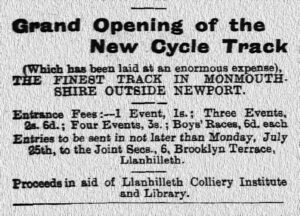 The First Cycling Track.
The First Cycling Track.
In April 1904 the Abertillery District Council was in the process of laying out the cycling track at the park. The track (as seen in the main featured image above) was to be a quarter of a mile around the perimeter of the football ground and the surface was to be covered in ash or cinder.
In May 1904 the Council’s Allotments and Pleasure Grounds Committee met at the park and decided to have a permanent fence erected around the cycle track, it was to be of the “post and tube” design. The Abertillery Cycle Track was laid at this time.
The Six Bells Cycling Club.
In June 1904 the Six Bells Cycling Club was advertised and was under the captaincy of Mr A. Redwood.
On Monday 25th of July 1904, the Council’s Allotments and Pleasure Grounds and Fire Brigade Committee met at the Council Offices, among the members present were as follows – Mr J. Tarrant J.P., (Chairman); Mr R. Downs; Mr Little; Mr E. J. Williams; Mr F. Athay and Mr W. Harris with the Assistant Clerk, (not named): At this meeting the clerk was instructed to obtain information on the regulations in force in Newport, Pontypridd and Carmarthen respecting cycle tracks. It was resolved that the use of the Abertillery Recreation Grounds and Cycle Track on the 3rd August of the same year, be granted to the committee of the Llanhilleth Institute for free, though subsequent occasions a recognised fee of £10 be payable. Mr Athay remarked that the ash cinder cycle track would be “A great source of expense until the council went a little further and covered it with asphalt”. On the motion of Mr Athay and seconded by Mr Little the surveyor was instructed to proceed with the asphalting of the track.
The New Ash Cinder Cycle Track.
On Wednesday 3rd of August 1904, at a Grand Annual Athletics Sports event at the park, Abertillery the newly laid ash cinder cycle track was opened. It was advertised as being “The finest track in Monmouthshire outside Newport”. The council issued terms of use and laid out the following charges – Recreation ground and cycle track use £10 per annum for holding sports etc with annual tickets at 10s. each. Use of cycle track per day 6d. It was also stated the surveyor proceed with the laying of a new asphalt track.
On Saturday 3rd of September 1904, a Cycle Race was held on the new ash cinder track at the Abertillery Park. The champion record holders Mr A. W. Coles and Mr Jack Cook competed in a 10 guinea race “the best of three” and an attempt to break the 5 mile record was planned by Mr H. G. Appleton of Bristol. The competition didn’t go smoothly one of the competitors Mr Jack Cook fell of his bike in a practice lap and badly cut his legs and arm. Mr A. W. Coles went on to win, the first event was a mile which he achieved in 3 min 30 sec, second race was three mile which he again won in 9 mins and the third and last race was a five-mile race which he won with a time of 15 mins 52 secs. Mr Coles later tried to beat the Abertillery Track Record but retired exhausted after doing 3 miles.
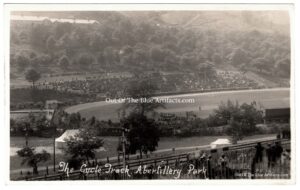 The New Cycle Track.
The New Cycle Track.
In June 1905 the council had laid down a new asphalt cycle track to replace the old ash cinder track and it was to be officially opened during the Annual Whitsun Sports Day on Tuesday June 13th, 1905. The sporting events were also held on the Wednesday 14th of June. It was a two-day event.
Work on the ash cinder and the new asphalt cycle track was spread over a period of about a year, with an outlay of about £700 with most of that amount expended on labour. However at a meeting of the Trading Committee this expense was questioned and it was believed the true amount was close to £1,000 though in July 1905 at a Local Rate Payers meeting held at the Oddfellows Hall, Abertillery a Labour representative on the council declared the true cost of the cycle track at being £600 and he stated that the track would be a source of revenue by holding sports and games at a charge of £10 per day.
In February 1906 the headquarters of the Cwmtillery Cycling Club was Carter’s Temperance Bar. At a meeting of the club there was a presentation where Mr E. Hodges was presented with a clock and a vase, Mr M. Cole a family Bible, Mr J. Hodges a clock, Mr J. King a writing case, Mr G. Wiltshire a sweater and Mr C. Squires a pair of cycling hose.
In April 1906 the committee of the Abertillery Agricultural Show was granted use of the Abertillery Recreational Ground for holding their show in July, provided the cycle track be protected by the use of hurdles and the surface where competitors horses and visitors may tread be boarded over. The council also unanimously agreed to reduce the charge for a season ticket at the park from 7s. 6d. to just 5. shillings. The council also made arrangements for one of their employees to superintend the riding on the cycle track.
On Tuesday 17th of April 1906, the Council Pleasure Ground Committee met, the following members attended – Mr E. J. Williams; Mr G. Little; Mr G. Purnell; Mr D. Smith and Mr W. Lewis with the officers: At this meeting it was resolved that a new updated charge for the use of the cycle track be put forth as follows – Non residents 10s per annum, residents over 16 years of age 5s per annum and boys under the age of 16 years 3s per annum. Boys over 16 years of age 6d per day and boys under 16 years of age 3d per day. It was stated that a numbered ticket book be provided for the caretaker of the cycle track and no one without a ticket should be allowed to ride on the track, also the tickets were non-transferable.
In May 1907 at an Abertillery District Council meeting it was mentioned that the outlay of the cycle track was close on £1,000 and that they had nothing back in return, they could not get anyone to pay the fee for the use of the track.
Personal Insurance.
In May 1907 Messrs Morgan, an ironmonger of Abercarn offered free insurance to anyone purchasing bicycles from them. The policy was £1 per week pay-out in case of any accident.
In July 1909 problems with the charging again arose when it was brought to the council’s attention that people from Newport were using the cycle track to practice on it for sports etc and were not paying. The chairman of the committee said something should be done to make outsiders pay yet let those who resided in the area practice for free. Once again it seemed to go unresolved as to a lack of effort in making people pay the required fees.
On Wednesday 26th of July 1911, the cycle track was the venue for the Harriers Allmark Challenge Cup, 3 mile race, given for competition in connection with Abertillery.
Cwmtillery Cycling Club.
In June 1914 a new cycling club was formed at Cwmtillery, the South Wales Gazette reported on meeting held with the purpose of organising a cycling club for the district. It stated that the old established Cwmtillery Club had been renamed and up-to-date rules had been adopted. The officials at the club were as follows – Mr William Brace M.P., (President); Messrs H. Campion; G. Ihringer; J. Hellier; H. G. Thomas; M. Coles; T. Morgan; J. Powell; W. Bibey and Dr James (Vice-Presidents): Messrs E. H. Wilson and J. Hodges (Joint Secretaries): Mr G. Wiltshire (Treasurer); Mr A. Parker (Captain): Messrs J. Hodges and E. H. Wilson (Joint-Captains): Messrs A. Worton; A. Roberts; R. Phillips and F. Tuckfield (Committee):
The Demise of the Cycling Clubs.
After the great war and throughout the 1920’s information on the cycling clubs have been hard to find. In March 1925 a letter was written by an Abertillery resident and published in the local paper. In it he wrote of his concerns for Abertillery in the way the council were running the finances and allowing the area to be run down and desolate, of the great expenses wasted on the cycle track, band stand and dancing area etc and none of them ever getting used. The best flower gardens and park in the area at Glandwr Street now desolate and barren.
In September 1927 Greyhound Racing was first proposed to be held at Abertillery Park. It was said to be very popular at that time and though it was only held in large populated towns there was no reason why it couldn’t take off in smaller places. The canvassing of the practicability of providing Greyhound Racing at Abertillery had been in operation for some weeks, the football ground and cycle track was suggested as such a site. Abertillery could attract large crowds and an abundance of bookmakers, the town could provide such a draw. Though it was also be said that Abertillery could be a place where the evils of betting would be frowned upon.
North Gwent Cycle Club.
In the early 1930’s the North Gwent Cycle Club was formed, reports from the South Wales Gazette from May 1932 states that the club was formerly the Blaina and Abertillery Cycling Club.
The Abertillery Road Club.
During the mid to late 1930’s the cycle riders at Abertillery were associated with the Abertillery Road Club, this club was affiliated to the Glamorgan and Monmouth Racing League. Some of the club members included – Mr J. Jones; Mr C. Page; Mr Cyril Collier; Mr R. Baynham; Mr W. J. Drake; Mr G. D. Zucca and Mr I. Llewellyn: The officers of the club were – Mr W. J. Drake (Race Secretary); Mr G. D. Zucca (Secretary) and Mr C. Page (Treasurer):
The Six Bells Wayfarers Cycling Club.
On Friday 7th of July 1939, the South Wales Gazette reported on the formation of the Wayfarers Cycling Club based at Six Bells, Abertillery. It stated that the club members numbered twenty and the previous Sunday 2nd of July the club cycled to the Wye Valley, had dinner at Chepstow and tea at Monmouth, they returned home via Usk and Pontypool. Nothing more could be found on this cycling club?
Abertillery and District Wheelers Cycling Club.
During the 1940’s the cycle club was once again named the Abertillery Wheelers, known officially as the Abertillery and District Wheelers Cycling Club.
(More information to come).
Later the cycle track was used for cycle racing, athletics and sports etc but since the new grandstand has been constructed the track is no longer in a usable state for what it was originally designed for.
Points of interest – In May 1921 money amounting to the sum of £350 was given by the secretary of the parks Improvement Committee for terracing at the football ground. The work on the new terracing was carried out by 25 unemployed workers of Abertillery under the instructions of the chief surveyor Mr L. D. Lewis (son of the former Cwmtillery Collieries General Manager and ex-Councillor Mr Daniel Lewis of Blaenau Gwent). The Unemployment Workers Scheme was carefully managed and none of the men working in connection with it had less than six children under fourteen years of age, one man had a family of thirteen children.
 Out Of The Blue Artifacts A Library of a lifetime of collecting
Out Of The Blue Artifacts A Library of a lifetime of collecting
